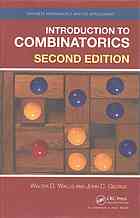

Most ebook files are in PDF format, so you can easily read them using various software such as Foxit Reader or directly on the Google Chrome browser.
Some ebook files are released by publishers in other formats such as .awz, .mobi, .epub, .fb2, etc. You may need to install specific software to read these formats on mobile/PC, such as Calibre.
Please read the tutorial at this link. https://ebooknice.com/page/post?id=faq
We offer FREE conversion to the popular formats you request; however, this may take some time. Therefore, right after payment, please email us, and we will try to provide the service as quickly as possible.
For some exceptional file formats or broken links (if any), please refrain from opening any disputes. Instead, email us first, and we will try to assist within a maximum of 6 hours.
EbookNice Team

Status:
Available5.0
23 reviewsWhat Is Combinatorics Anyway?
Broadly speaking, combinatorics is the branch of mathematics dealing with different ways of selecting objects from a set or arranging objects. It tries to answer two major kinds of questions, namely, counting questions: how many ways can a selection or arrangement be chosen with a particular set of properties; and structural questions: does there exist a selection or arrangement of objects with a particular set of properties?
The authors have presented a text for students at all levels of preparation. For some, this will be the first course where the students see several real proofs. Others will have a good background in linear algebra, will have completed the calculus stream, and will have started abstract algebra.
The text starts by briefly discussing several examples of typical combinatorial problems to give the reader a better idea of what the subject covers. The next chapters explore enumerative ideas and also probability. It then moves on to enumerative functions and the relations between them, and generating functions and recurrences. Important families of functions, or numbers and then theorems are presented. Brief introductions to computer algebra and group theory come next. Structures of particular interest in combinatorics: posets, graphs, codes, Latin squares, and experimental designs follow. The authors conclude with further discussion of the interaction between linear algebra and combinatorics.